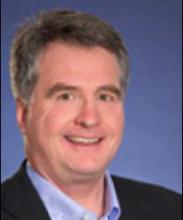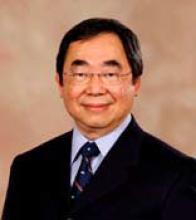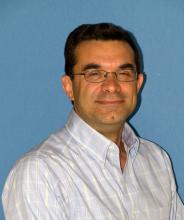CMOS comparators: Basic Circuits All Over Again

Dr. Tom Matthews
Chair
Electrical & Electronic Engineering Department, CSU Sacramento
Thu, 03/27/2014
Abstract – Regenerative comparators are an important element in many contemporary analog and mixed-signal integrated circuit (IC) designs, including pipelined and flash analog-to-digital converters. The presenter will discuss his experiences with the design of this particular functional block of circuitry, and how a quest to discover what really determines the output of such comparators led all the way back to convolution and Fourier transforms. Some design considerations will be discussed, but the presentation will focus on basic principles of operation and should be accessible to beginning students. An important specification of such comparators is the input offset voltage. The presentation will also show how basic principles of negative feedback can be employed in simulations to accurately determine the offset specification.
Dr. Thomas W. Matthews received the B.S. and M.S. degrees in electrical and electronic engineering from California State University Sacramento in 1978 and 1989, respectively. He received the Ph.D. degree in electrical engineering from University of California Davis in 1994. From 1995-1998 he taught in the Department of Electrical Engineering at San Jose State University. In 1999 he started teaching at California State University Sacramento where he is currently Professor and Chair of the Department of Electrical and Electronic Engineering. He has consulted for Analog Devices in Wilmington, MA and for Intel in Sacramento, CA.
Analyzing and Avoiding Failures in Electronics and Life

Ms. Julie Silk
Environmental Compliance Program Manager
EMG Customer Experience and Quality, Agilent Technologies
Thu, 03/06/2014
Abstract – Customer expectations for lifetimes of electronic products vary with the type of equipment, with cell phones that could last less than 3 years to expensive high technology equipment that is expected to last over a decade. The lifetime of electronic equipment is often dependent on the reliability of the printed circuit assemblies that contribute much of the function of the product. These assemblies have increased in complexity as more and more performance is added in smaller and smaller packages. With the European Union directive on the Restriction of Hazardous Substances, higher melting point lead-free solder is used, resulting in added material challenges and failure mechanisms. This lecture will provide understanding of basic printed circuit board construction, printed circuit assembly processes and the materials used. Failure analysis techniques and the metallurgy of solder joints will be described. A variety of printed circuit failures are used to illustrate the failure mechanisms, the design rules or process requirements that avoid these failures, and a few life lessons.
Ms. Julie Silk is the Environmental Compliance Program Manager for the Electronic Measurements Group of Agilent Technologies. She has had a focus on printed circuit assembly design, quality, reliability and supplier development. She has a BS in Chemical Engineering from the University of Washington and has worked for Hewlett-Packard and Agilent Technologies for over 30 years. A recent graduate of Leadership Santa Rosa, she also is dedicated to encouraging young women to enter engineering fields through Agilent’s Introduce a Girl to Engineering Day and as president of the non-profit Expanding Your Horizons Sonoma County.
Programmable Networks: How software programmability and automation transform networks, improve performance and reduce costs

Mr. Steve West
Chief Technical Officer
Cyan
Thu, 02/20/2014
Abstract – Data and telecommunications networks reach to every corner of the globe. Wherever you go on the planet, you can be in touch with your work, and friends, and up to date on sports, news and entertainment. In the fruits of these tremendous accomplishments lie the seeds of disruptive change that will redefine how global networks are built and operated. The network is undergoing metamorphosis. The constraints of the past no longer apply. It’s less about technology, and more about applications. The network works, now it’s about making it work better, and to make the network personal for each end-user. The focus has changed from hardware to software. This talk will discuss how optical and electronic technologies are enabling a programmable multi-technology network that is programmability. In this new network automation, speeds deployment and reduces costs. And automation extends control to the end-users enabling new applications.
Mr. Steve West is a co-founder and CTO of Cyan, a Petaluma based networking solutions company. Steve is responsible for technology direction. Steve was previously a founding member of Turin Networks team, where he was responsible for product architecture. Prior to Turin Steve was Director of Engineering at Advanced Fibre Communications. Steve has BSc and MSc degrees in Engineering from the University of the Witwatersrand in Johannesburg, South Africa.
Electronic Measurement Uncertainty and Implications

Mr. Ken Wong
Manager
Agilent Technologies
Thu, 02/06/2014
Abstract - What is measurement uncertainty? What are the major contributors to electronic measurement uncertainties? Why shall we care? From laser tape measures, home electronic blood pressure monitors to weather satellites, electronic measurements are employed in various capacities. Measurement uncertainty is the key parameter that defines the capability of all these measurement apparatus. Through continuous research efforts in measurement science and technology to reduce measurement uncertainties, we get a more confident assessment of our own health, our environment, and our safety. This presentation will cover the basics of measurement uncertainty, some of the latest developments in measurement uncertainty reduction and future impacts.
Mr. Ken Wong has been with HP/Agilent for over 40 years. His experience at HP/Agilent includes product design, manufacturing process and metrology development. He is currently responsible for the development, modeling and measurement of microwave reference standards and calibration methods. He collaborates regularly with NIST (National Institute of Science and Technology) and other national metrology institutes on VNA (vector network analyzer) calibration standards modeling, uncertainties, and verification. He has published and presented many papers on VNA calibration and standards. He was granted over a dozen patents.
An International Teaching Experience: Challenges and Rewards

Dr. Farid Farahmand
Assistant Professor
Engineering Science Deptartment, SSU
Thu, 11/21/2013
Abstract - In this talk, we explore the challenges and rewards of teaching overseas. We share some of our personal experiences during our 7-month stay in Ghana and point out the difficulties facing academic institutions in the country. We examine opportunities for introducing new technologies to improve the education system in developing countries. We further recount on the importance of "appropriate" technologies aiming at improving the standard of living for the developing world. We offer personal accounts as to how such technologies can greatly impact living conditions of many people and how students, particularly STEM majors, can be engaged in collaborative multidisciplinary international projects involving humanitarian technologies. Finally, we conclude by presenting available volunteer opportunities for faculty and students to visit West African countries and potential contributions they can make, while experiencing the incredible natural beauty, cultural richness, and human kindness in the region.
Dr. Farid Farahmand received his PhD in 2005 and is currently an Assistant Professor in the Department of Engineering Science at Sonoma State University. He is also the director of Advanced Internet Technology in the Interests of Society Laboratory. Prior to this position, Dr. Farahmand worked as the research scientist at Alcatel-Lucent Corporate Research and was involved in development of terabit optical routers. Dr. Farahmand holds multiple international patents, numerous reference conference articles and journal publications, and several book chapters, on the subjects of wireless communications, optical networking, green networking, and delay tolerant networks. He has also authored many educational papers focusing on eLearning and Active Learning in classrooms. Farid is actively involved in many conferences and serves as the reviewer and co-editor to a number of technical conferences and journals. He is a member of IEEE, ASEE, and Engineers Without Borders-USA.